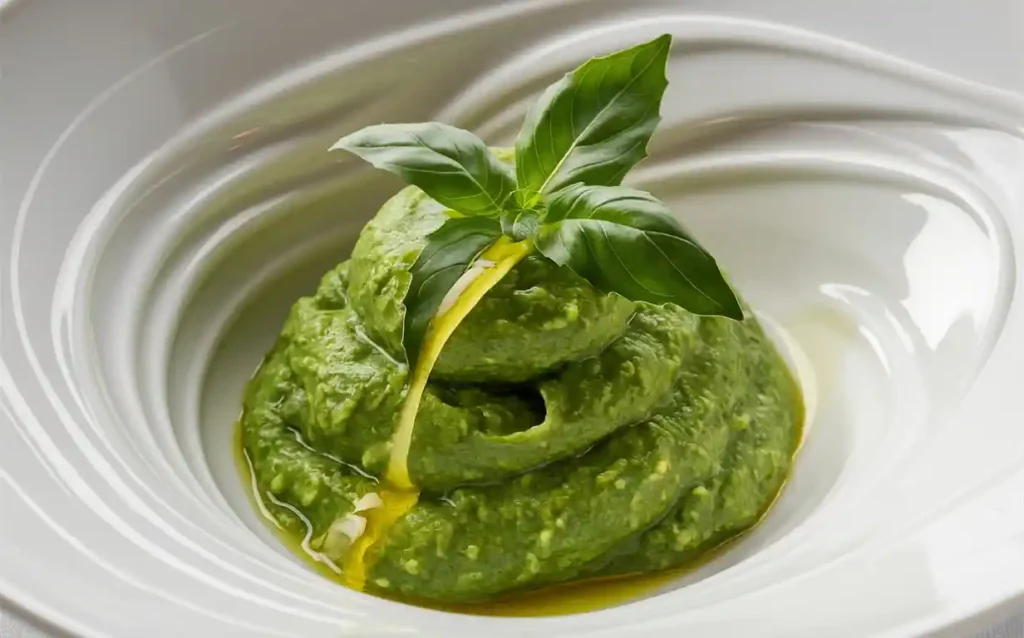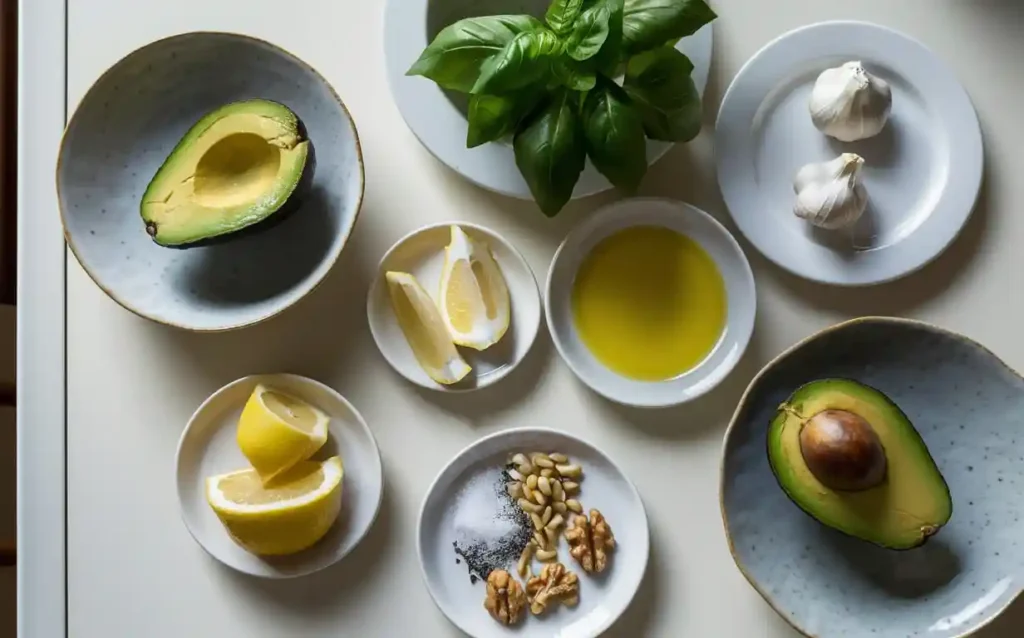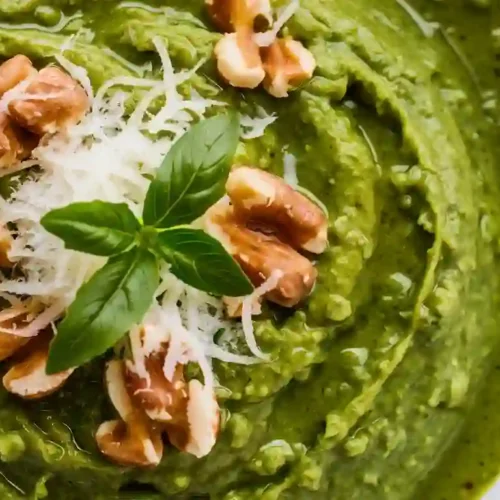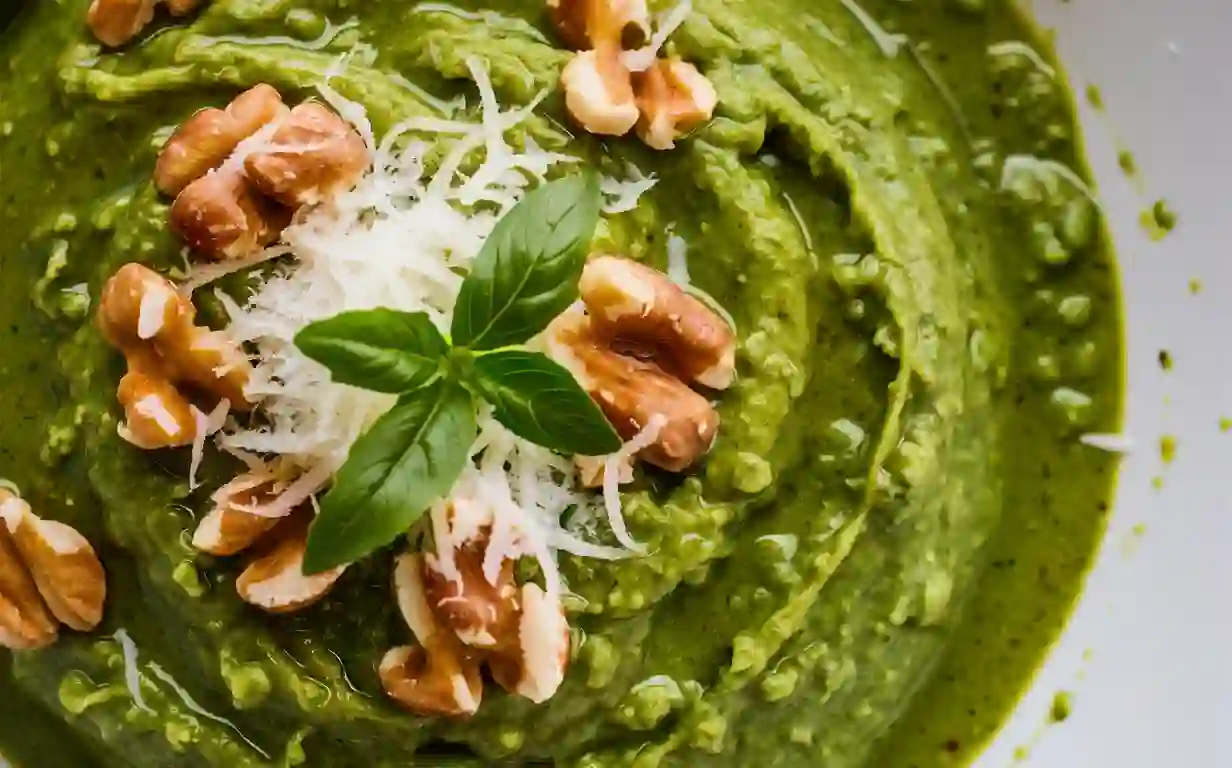Last Updated on May 31, 2025 by Lucas
Craving a creamy, vibrant sauce that’s ready in minutes? This avocado pesto is your new go-to. Made with fresh basil, ripe avocado, and a splash of lemon juice, it’s a quick, healthy twist on classic pesto. Whether you’re tossing it with pasta, spreading it on sandwiches, or drizzling it over grain bowls, this 15-minute recipe adds bold, feel-good flavor to any meal. Let’s blend up something delicious—you won’t believe how easy it is.
Key Benefits of Avocado Pesto
Avocado Pesto: A Creamy Essential You’ll Love
When you think of comfort food that’s also good for you, avocado pesto might not be the first thing that comes to mind—but it should be. This vibrant green sauce is more than just a pretty topping. It’s a nutrient-packed flavor enhancer that comes together in just minutes and transforms even the simplest meals into something special.
Let’s explore why it deserves a spot in your weekly meal rotation:
Quick & Easy
Life gets busy, and you don’t always have time to prepare elaborate meals. With avocado pesto, there’s no need to compromise flavor for convenience. In just 15 minutes—or less—you can have a silky, homemade sauce ready to elevate your pasta, toast, or salad.
No stovetop, no complicated steps. Just a blender or food processor, and you’re done.
Practical Tip:
Keep ripe avocados on hand or freeze peeled halves so you can whip this up anytime.
Healthy & Wholesome
Avocado pesto is loaded with nutrients your body will thank you for. Avocados alone are rich in monounsaturated fats, which support heart health, and they’re a source of fiber, potassium, and vitamin E [1].
Fresh basil brings antioxidants, while garlic may help support immune function. It’s a smart way to make your meals both nourishing and satisfying.
Nutrient Boost:
Swap in nutritional yeast for a vegan cheese flavor and an extra hit of B vitamins.

Diet-Friendly & Customizable
Whether you’re following a vegan, dairy-free, or gluten-free diet, this avocado pesto checks all the boxes. It’s naturally plant-based and adaptable—so you control what goes in.
Here’s how to tailor it to your needs:
- Dairy-Free: Use nutritional yeast instead of Parmesan.
- Nut-Free: Sub sunflower seeds or skip them altogether.
- Low-Carb: Pair it with spiralized zucchini or roasted veggies.
Versatile Uses in Your Kitchen
This isn’t just a pasta sauce—it’s a kitchen multitasker. You can enjoy it as:
- A dip for crisp veggies or pita chips
- A sandwich spread or wrap enhancer
- A topping for grilled proteins like chicken or tofu
- A dressing over grain bowls or cold salads
Its creamy texture makes it easy to spread, drizzle, or scoop, while the bold flavor ties dishes together without overwhelming them.
Why You’ll Keep Coming Back
You’re not just saving time—you’re boosting flavor, nutrition, and creativity in the kitchen. Whether you’re prepping weekday meals or entertaining guests, avocado pesto offers a rich, vibrant touch that feels indulgent but stays wholesome.
👉 Try it once and you’ll find endless ways to use it.
Ingredients You’ll Need for Avocado Pesto
Making avocado pesto at home is both simple and satisfying. With a few fresh ingredients and a blender or food processor, you’ll have a creamy, nutrient-rich sauce ready in no time. Let’s walk through what you’ll need—and how you can adapt each item to fit your preferences or dietary needs.
To make this easier to follow, here’s a structured ingredient table with optional swaps:
| Ingredient | Purpose | Substitution Options |
| Ripe Avocado | Provides creamy texture and healthy fats | No suitable substitute |
| Fresh Basil Leaves | Delivers the signature pesto aroma and taste | Baby spinach or parsley (milder flavor) |
| Garlic Cloves | Adds depth and sharpness | Roasted garlic for a milder bite |
| Fresh Lemon Juice | Brightens flavor and balances richness | Lime juice in a pinch |
| Extra Virgin Olive Oil | Helps emulsify and smooth the sauce | Avocado oil or light olive oil |
| Sea Salt & Black Pepper | Enhances overall flavor | Adjust to taste |
| Parmesan Cheese | Boosts umami and creaminess | Nutritional yeast (for dairy-free) |
| Pine Nuts | Traditional nutty base | Walnuts, almonds, or sunflower seeds |

Ingredient Breakdown & Insights
Avocado
Use a ripe, buttery avocado for best results. It gives the pesto its luscious consistency and is packed with heart-healthy monounsaturated fats. Avocados are also rich in potassium, fiber, and folate, making this sauce as nourishing as it is tasty [2].
Tip: If you don’t have a perfectly ripe avocado, place it in a paper bag with a banana for faster ripening.
Fresh Basil
Basil is essential to pesto’s identity. It brings a fragrant, slightly sweet note that balances the richness of the avocado. If you’re short on basil, mixing in some spinach or parsley can mellow the flavor without sacrificing that vibrant green color.
Garlic & Lemon Juice
Garlic gives your avocado pesto a bold, savory kick, while lemon juice cuts through the creaminess to keep the sauce bright and balanced. Lemon also helps slow oxidation, keeping your pesto greener for longer.
Olive Oil & Seasonings
Use high-quality extra virgin olive oil for the best flavor. It acts as the emulsifier, blending all ingredients into a smooth sauce. Season with sea salt and pepper to your liking—start small, then adjust after tasting.
Parmesan or Nutritional Yeast
Parmesan cheese gives the pesto that classic umami depth. For a vegan or dairy-free version, nutritional yeast is a fantastic substitute. It adds a cheesy taste while also providing B vitamins and protein.
Nuts or Nut-Free Alternatives
Pine nuts are traditional in pesto recipes, but feel free to substitute based on availability or allergies:
- Walnuts for an earthy richness
- Almonds for a subtle crunch
- Sunflower seeds for a completely nut-free version
Roast the nuts lightly for a deeper flavor, but you can use them raw for a softer profile.
By preparing these simple, fresh ingredients in advance, you’ll find the actual blending process incredibly smooth. Ready to move on? In the next section, we’ll walk through step-by-step instructions to bring your avocado pesto to life.
Instructions
Creating avocado pesto at home is simple, quick, and deeply rewarding. With just a few whole ingredients and a basic kitchen appliance, you can prepare a vibrant green sauce that’s rich in flavor and nutrients. Whether you’re making it for pasta, a spread, or as a dip, follow this straightforward guide to get it right every time.
Step 1: Prep the Ingredients
Start with fresh, ripe components to achieve the best flavor and texture.
- Pit and scoop the avocado using a spoon. Make sure it’s soft to the touch but not overripe.
- Rinse the basil gently under cold water. Pat it dry to prevent excess moisture in the pesto.
- Peel the garlic: A small clove gives bold flavor—add more if you like it punchier.
- Measure your ingredients and keep them ready. This includes olive oil, lemon juice, salt, pepper, and your chosen nuts.
Tip: Use a digital kitchen scale for accuracy if you’re batch-prepping.
Step 2: Blend Until Smooth
Now it’s time to bring everything together.
- In a food processor or blender, add the avocado, basil, garlic, lemon juice, olive oil, salt, and pepper.
- Toss in the parmesan or nutritional yeast, if using.
- Add your preferred nuts—pine nuts, walnuts, or sunflower seeds.
Blend until the mixture turns into a creamy, cohesive paste. Scrape down the sides as needed to ensure even blending.
Texture Tip: If your pesto feels too thick, drizzle in a little more olive oil or a spoonful of warm water to loosen it.
Step 3: Adjust the Seasoning
Taste matters—and everyone’s palate is a little different.
- Add more salt or lemon juice if the flavor feels flat.
- A dash more pepper or garlic can bring extra depth.
- Want it nuttier? Toss in a few extra seeds or nuts and pulse again.
Use short blending bursts when adjusting to avoid overprocessing.
Step 4: Serve Immediately or Store
Once you’re satisfied with the flavor and texture:
- Use the avocado pesto right away for the freshest flavor and color.
- Or store it in a glass jar with a tight lid. Press a piece of parchment against the surface to minimize browning.
Refrigerate for up to 2 days, though for the best taste and bright green hue, it’s ideal to enjoy it the same day.
This step-by-step method makes preparing avocado pesto feel intuitive and efficient. With just a few minutes of hands-on time, you’ll create a fresh, flavorful condiment that can instantly elevate your meals. Now that you know how easy it is, you’ll want to keep a batch in your fridge at all times. Ready to see how to make it your own? Let’s explore some tips and creative variations next.
Pro Tips and Variations
Avocado pesto is a creamy, vibrant twist on the classic sauce, offering both flavor and nutrition. Whether you’re aiming for a vegan delight, a nut-free option, or simply exploring new tastes, here are some expert tips and variations to elevate your avocado pesto experience.
Use Ripe Avocados for Optimal Creaminess
Selecting a perfectly ripe avocado ensures a smooth and luscious texture. A ripe avocado should yield slightly to gentle pressure and have a rich green hue beneath the stem. Overripe avocados may introduce bitterness and an undesirable color to your pesto.
Make It Vegan with Nutritional Yeast
For a dairy-free version, replace Parmesan cheese with nutritional yeast. This ingredient imparts a savory, umami flavor reminiscent of cheese, making it ideal for vegan diets. Additionally, nutritional yeast is rich in B-vitamins and protein, enhancing the nutritional profile of your pesto.
Swap the Nuts or Go Nut-Free
Traditional pesto includes pine nuts, but you can customize your avocado pesto to suit dietary needs or preferences:
- Sunflower Seeds: Offer a nut-free alternative with a mild flavor.
- Pumpkin Seeds: Provide a slightly sweet and earthy taste.
- Omit Nuts Altogether: The avocado’s creaminess can stand alone, creating a smooth pesto without any nuts or seeds.
Add a Kick with Spices
Introduce a touch of heat to your avocado pesto for an exciting flavor twist:
- Red Pepper Flakes: Sprinkle in for a subtle, warming spice.
- Fresh Jalapeño: Blend in a small amount for a more pronounced heat.
- Smoked Paprika: Adds a smoky depth that complements the creamy avocado.
Adjust the quantity to match your spice tolerance and desired flavor intensity.
By experimenting with these variations, you can tailor your avocado pesto to match your dietary needs and taste preferences, ensuring a delightful addition to a variety of dishes.preferences, ensuring a delightful addition to a variety of dishes.
Serving Suggestions That Shine
You’re not limited to pasta. This avocado pesto is your kitchen companion for creative, nourishing meals. Use these serving ideas to inspire your next dish:
- Pasta Sauce
Stir it into warm spaghetti, penne, or zucchini noodles. The heat helps loosen the sauce, coating every bite. For extra texture, toss in cherry tomatoes or sautéed mushrooms. - Sandwich or Wrap Spread
Swap out mayo or hummus and use this instead. It brings a cool, creamy richness to wraps, grilled sandwiches, or even breakfast toast layered with eggs or tomato. - Grain Bowls & Salads
Spoon it over a quinoa or couscous base, then top with roasted vegetables, beans, or grilled chicken. It also works well as a dressing—just thin it with a splash of water or lemon juice. - Dip or Appetizer
Serve it chilled with crisp veggies, pita chips, or on toasted bread rounds. A sprinkle of chili flakes or crushed walnuts adds a pop of texture for guests or snacking.

With a single batch of avocado pesto, you unlock a world of vibrant, satisfying meals that are just as nourishing as they are flavorful. Use it fresh or refrigerate it in a tightly sealed jar for up to two days. For longer storage, spoon it into an ice cube tray, freeze, and pop out a cube when you need a flavor boost.
Tip: To maintain that bright green color, cover the surface with plastic wrap before sealing. Oxygen is what causes browning, so this helps keep it looking fresh.
Let this pesto become your go-to for quick, wholesome meals. And once you’ve tried it, don’t be surprised if it ends up in your weekly rotation.
Conclusion
Avocado pesto is the quick, healthy, and delicious sauce your meals are missing. With its creamy texture, fresh flavor, and endless uses, it’s a simple upgrade to everyday dishes. Whether you’re tossing it with pasta, spreading it on wraps, or using it as a dip, this 15-minute recipe delivers both taste and nutrition with ease. Plus, it’s easy to customize for any dietary need. If you’ve been looking for something vibrant, satisfying, and ready in minutes, this is it. Give it a try today—you might find yourself making it on repeat. Once you’ve tasted how good homemade avocado pesto can be, your kitchen routine may never look the same again. Ready to blend something great?

Avocado Pesto
Ingredients
- 2 ripe avocados pitted and peeled
- 1 cup fresh basil leaves
- 2 cloves garlic peeled
- 2 tablespoons lemon juice
- 1/4 cup olive oil
- 1/4 cup pine nuts or walnuts, optional
- Salt and pepper to taste
- 2 tablespoons nutritional yeast or Parmesan optional
Instructions
- Prepare ingredients by washing basil and peeling garlic.
- In a food processor, combine avocado, basil, garlic, lemon juice, and nuts.
- Slowly drizzle olive oil while blending until smooth.
- Season with salt and pepper. Add nutritional yeast or Parmesan if desired.
- Adjust lemon juice or oil for preferred consistency.
- Serve immediately or refrigerate in an airtight container.
Notes
- Calories: 180
- Fat: 16g
- Carbs: 8g
- Protein: 3g
- Fiber: 5g
- Sugar: 1g
FAQs
Can I make avocado pesto ahead of time?
Yes, you can prepare it in advance. Store the pesto in an airtight container and refrigerate for up to 2 days. Adding extra lemon juice helps keep the vibrant green color fresh.
Can I freeze avocado pesto?
Absolutely. Freeze your avocado pesto in small containers or use ice cube trays. This way, you can thaw just the right amount when you need it.
What can I use instead of basil?
Feel free to swap basil with spinach, arugula, or cilantro. Each option offers a unique flavor twist that keeps the pesto exciting.
Why does my avocado pesto turn brown?
Avocados oxidize when exposed to air, causing browning. To slow this, add lemon juice and keep the pesto sealed tightly in the fridge.


kg6met